Blockchain App Development: Full Overview
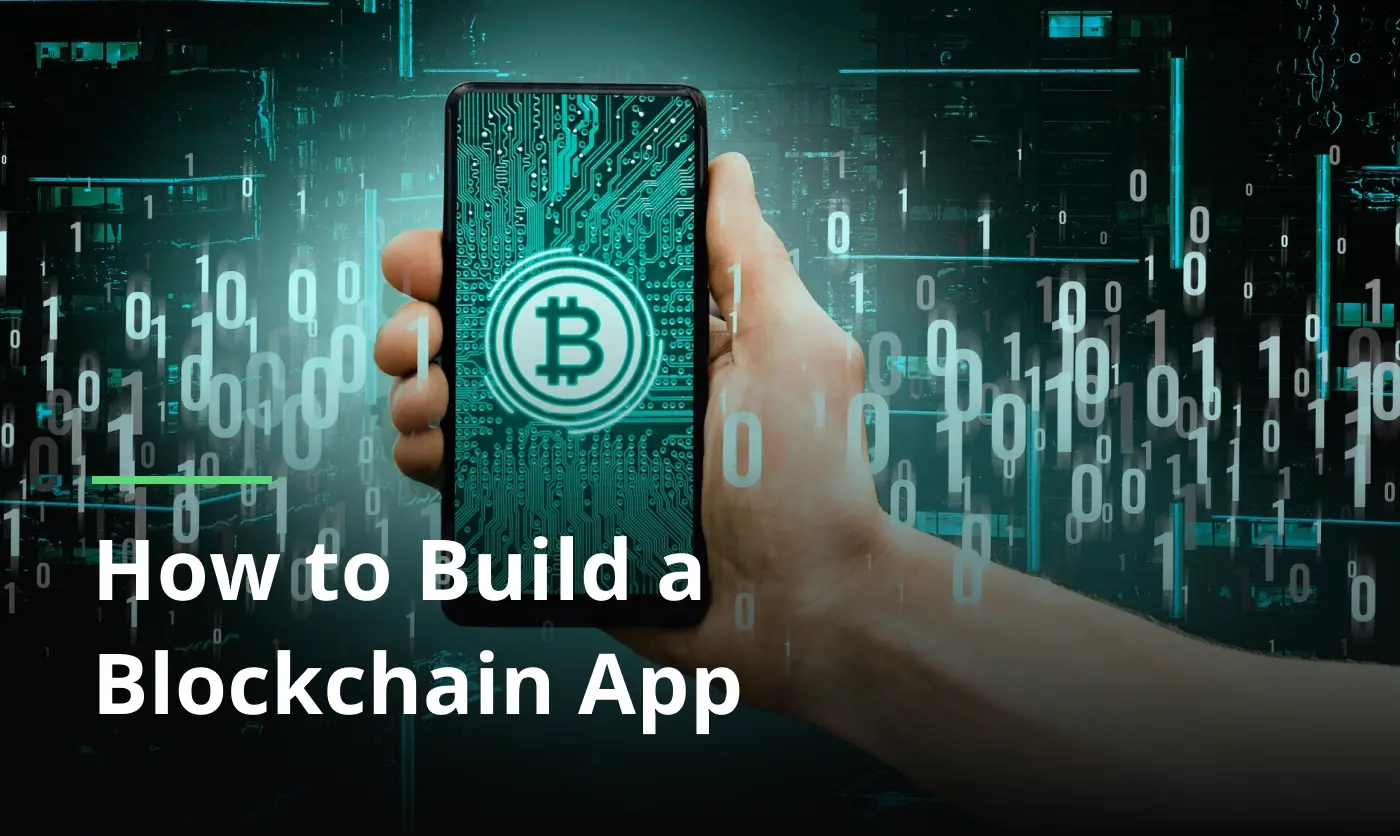
Blockchain app development is rapidly transforming industries, offering secure, decentralized solutions that are reshaping how we interact with data. At Limeup, we may outline key elements that make these systems both trustworthy and transparent.
Our extensive time in the industry has shown us that finance rewards the bold, but only when they’re precise. To develop a blockchain application that survives the twists and turns of cryptocurrencies, each component must be crafted with discipline and foresight.
Blockchain mobile app development is picking up speed, merging digital wallets, Web3 and privacy-first features into one powerful ecosystem. The demand for distributed-powered services continues to grow, raising the bar for privacy and security. Keeping pace in blockchain solutions means staying sharp on what’s rising. Let’s run through the most telling points from the review.
What is a blockchain application?
Simply put, such an app works as a self-contained next-gen system that depends on blockchain technology. Running like a well-oiled machine, the platform calls its own shots, executing a mixed bag of behind-the-scenes work, all driven by peer-to-peer ledger architecture. It works like a tamper-proof ledger system that needs no third party to uphold its reliability.
So let’s see in detail the most in-demand query, “What is blockchain application development?” The cryptographic chain is a digital bulwark, offering a steadfast and immutable audit trail for shielded business operations, especially within finance and supply chains. Users connect their devices directly, exchanging data that locks into place like pieces in a digital puzzle, forming an unbreakable chain.
A web of nodes keeps constant watch, validating each new entry and making tampering nearly impossible. This bold architecture strips away middlemen, replacing blind trust with mathematical proof and stamping out opportunities for fraud.
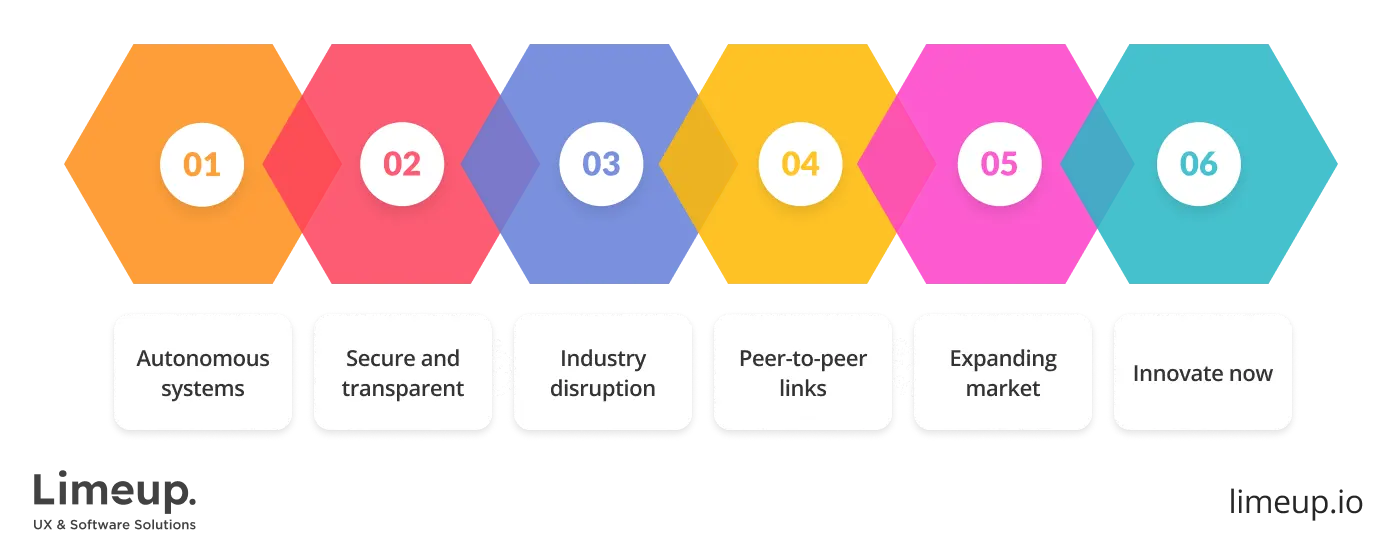
As the old saying goes, “Trust, but verify” and distributed ledgers take that to heart, recording every move with precision. On the edge of digital disruption, fintech app development providers turn high-stakes ideas into self-running systems built for the future. Such digital architects team up with clients to design and launch software that runs on its own steam.
These masterminds work their magic to build a blockchain app, cooperating with customers to strategize and roll out autonomous software. What you need are old hands at the job who can discern the key insights from the distractions and transform fresh innovation into lasting achievement.
As cryptographic ledger shakes up industries, they fortify security and enforce radical accountability, enabling companies to trim the fat and maximize efficiency. Rather than fading away, this innovation continues to revolutionize the digital economy, defining what’s next. Visionaries who embrace blockchain’s potential now will carve out the future of technology.
Тhe figures tell a compelling story — by 2030, the global peer-to-peer system market is expected to surpass $1.1 trillion, driven by its expanding role across finance, healthcare, supply chains and digital identity verification. Мajor players such as Visa, ІBM, JPMorgan are making substantial investments in a blockchain app developer, underscoring that this is not a passing fad, but a revolutionary force transforming industries.
Types of blockchain apps
With numerous blockchain systems available, each has its own function, collectively redefining the way digital interactions unfold.
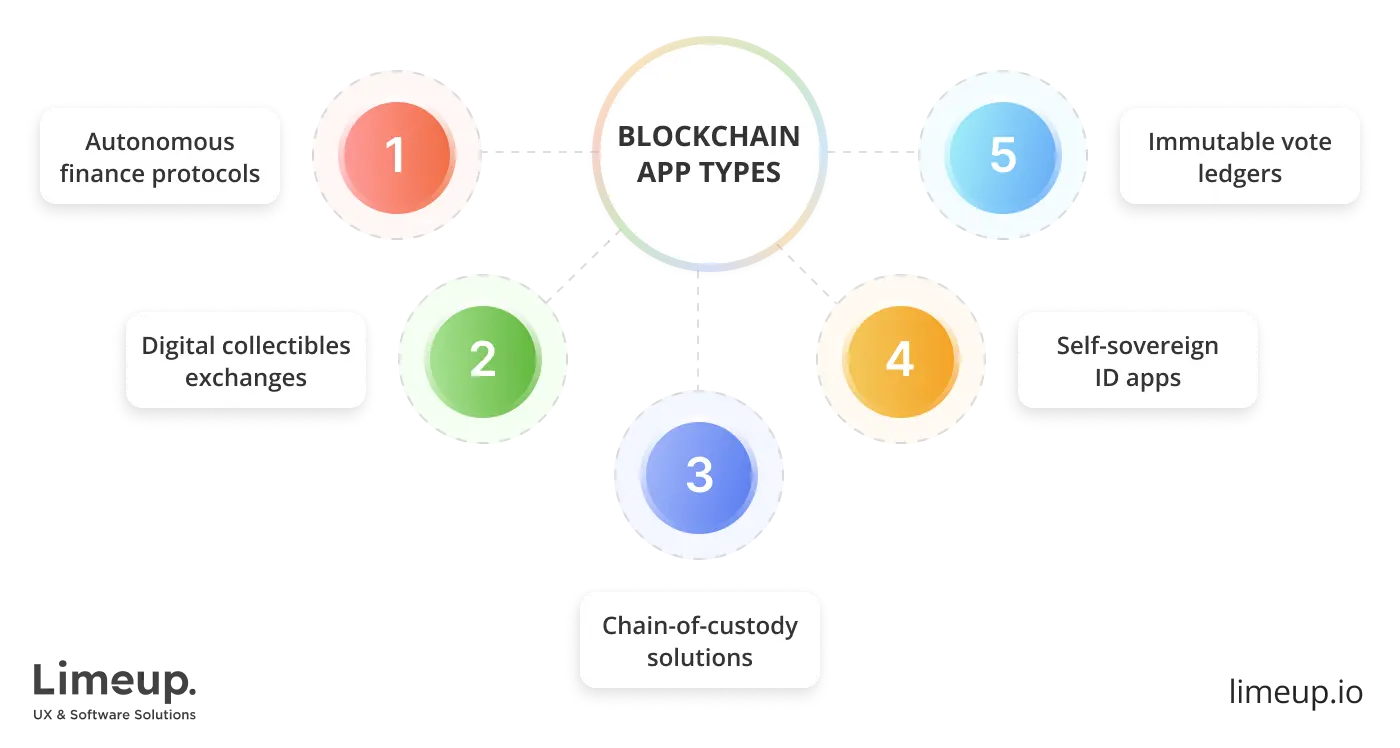
- Autonomous finance protocols
Вanks aren’t always built for speed, but smart contract-based DeFi networks are a different beast. Users can freely handle their assets and income generation and trades through systems that advance from blockchain app development without needing traditional banking institutions or cumbersome document stacks. The ultimate path toward financial independence happens when programmed code replaces middlemen as the primary leadership force.
- Digital collectibles exchanges
Take NFT marketplaces, for example. Through these digital domains creators gain the power to convert artistic creations and virtual footwear into tokens which permit direct selling to prospective buyers. Each transaction makes an impermeable entry into a digital ledger so users can track the secure identity of every object sold.
- Chain-of-custody solutions
Then we have the chain-operated mechanisms that bring clarity into global logistics by producing real-time inventory tracking. Transparency functions as the modern standard now that interruptions and delays fail to hide from system visibility.
- Self-sovereign ID apps
Contrary to sharing personal information on insecure computer servers users possess a blockchain-based single secure identity vault enabling control over digital identity data access. Individuals who subscribe to such models now safely manage their data collection from one central protected system which shields them from unauthorized entry or data leaks.
- Immutable vote ledgers
And we cannot mention that modern era marks the end of imprecise results along with ambiguous procedures. A voting app based on blockchain ensures the real-time audibility of every vote which helps rebuild confidence in the secure operation of elections.
Now is the moment to dive into the revolution made by blockchain app development solutions. From launching dApps to putting up a fortress around transactions or redefining entire industries, DLT delivers a protected, future-ready framework. Those who act today will be the architects of tomorrow’s innovations. The only question remains: will you lead the charge or struggle to keep up?
How to build a blockchain app: main steps to take?
Turning a digital ledger idea into a fully functional software is a well-planned expedition. Every great build starts with a solid foundation, the right crew and a clear roadmap. From concept to launch, each stage is a crucial piece of the puzzle.
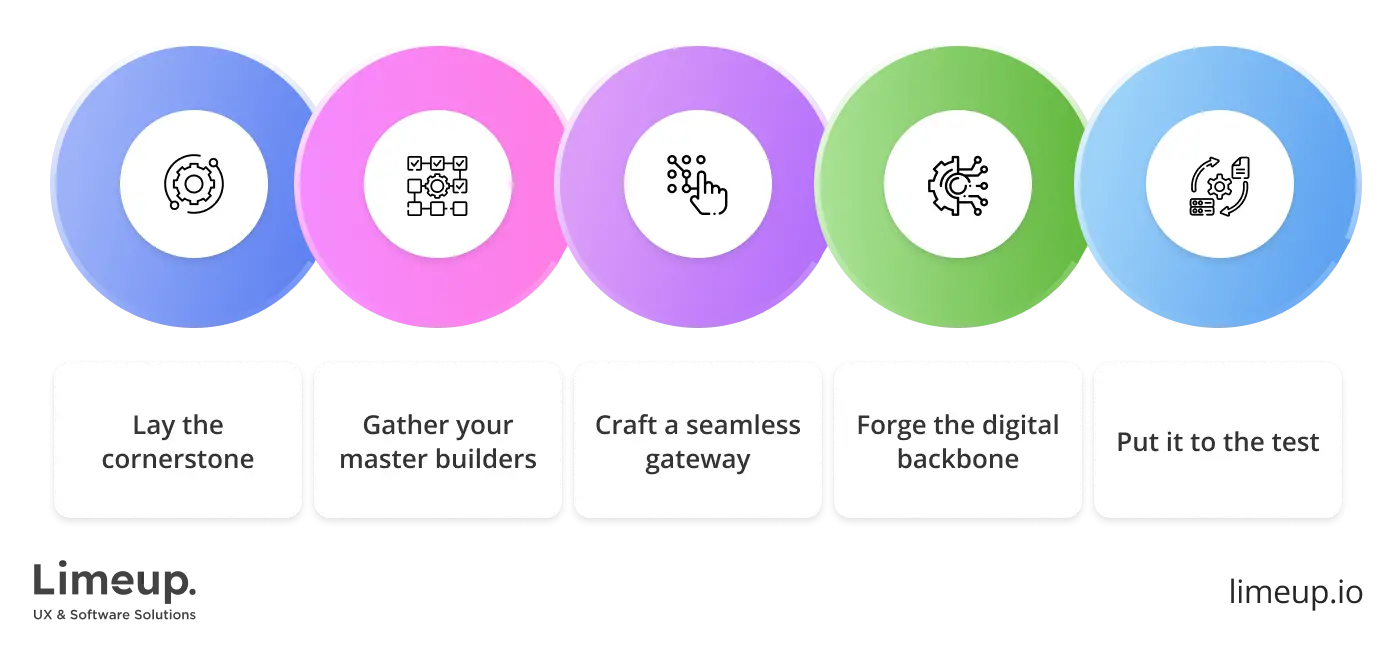
- Lay the cornerstone
A blueprint represents the starting point for every masterpiece creation. You need to establish problem definition at the start point of custom blockchain application development. How does your venture vaddress an exclusive problem? This step involves examining which non-concentrated network characteristics such as decentralization vigilance and transparency would create the best possible outcome.
Blockchain is the perfect tool for bringing an unbreachable level of trust and efficiency to your endeavor. Strong and focused visionary concepts play the essential role of transforming theoretical ideas into practical effective results. The defined problem together with its resolution set the gears in motion for building a game-changing product.
- Gather your master builders
No grand structure stands without expert hands. At this stage, hire blockchain developers with the right skills to craft a robust foundation, selecting the most suitable dispersed ledger network and protocols. DLT is no simple feat — it demands specialized knowledge in cryptography, non-centralized ledgers and smart contracts.
The selection between Ethereum and Solana or Hyperledger represents the same importance for skyscraper construction because all choices affect speed, defensiveness, agility and overall performance. Applications built by blockchain veterans are primed to stay strong, even as trends shift and challenges grow.
- Craft a flawless gateway
User Interface (UI) and User Experience (UX) design steps follow the establishment of the conceptual framework. The exceptional performance of blockchain-based programs results from their complex operational functions. Designing user interface elements demands a similar approach to simplify complex operations that need basic understanding from users. A smooth entrance system develops consumer loyalty since it provides a favorable experience.
- Forge the digital backbone
Custom blockchain app development requires choosing a cryptographic ecosystem as the central high-tech system that supports your project operations. The program stack decides between soaring success and eventual failure under stress. The most important factors at this point are growth capabilities together with transaction speed and security attributes and compatibility requirements.
Implementing cross-chain links and independent storage unlocks a more fluid and adaptable digital environment. The chosen technical stack functions as a determining factor regarding how well your app may be managed while receiving future updates.
- Put it to the test and unleash it
Success requires complete thorough testing of all innovations before they can be launched.Crupto-integrated engines must undergo tests to identify both operational difficulties as well as safety weaknesses and usage extensibility challenges. Apply it to real-world use scenarios which verifies it is able to execute blockchain-related operations assuredly and process user traffic and transactions with absolute reliability.
The last step involves public deployment which aims to bring venture into market space to cause disruption within an industry while creating lasting impacts. Your blockchain application development solution needs to escape into the world so it may demonstrate its capabilities to the global audience.
Following these phases makes it possible to transform basic innovative concepts into operation-ready programs that perform exceptionally well and demonstrate impressive features. Your path of engineering manifests equal significance as your final result.
What tech stack is used for blockchain application development?
Digital ledger software creation project demands a proper tech stack setup as essential tools to make it succeed. Your offering functions better with no reliability issues when you use appropriate toolkit to build it.
Fintech technology groundwork works as the main tool to maintain bulletproof transactions and protect personal information while allowing easy expansion. The foundation of every blockchain-based application development includes its ecosystem which safeguards fortified data storage while making it readily available.

Ethereum stands as a highly popular DLT service which offers strong capabilities related to smart contract execution. Hyperledger suits private system deployments but Solana demonstrates outstanding speed for transaction processing. Interoperable hubs Polkadot and Cardano would design high-value outcomes.
Successful fintech app development depends on your choice between these options since they control both transaction protection and speed. Engaging specialists who are able to embed cryptographic tools ensures smooth financial operations and secure handling of digital funds.
When considering how to build a blockchain application, picture it like building a strong edifice. The right mix of technologies keeps performance running like clockwork, with rock-solid security and room to grow.
- Among the most notable blockchain networks are above mentioned Ethereum, Solana, Hyperledger, Polkadot, Cardano.
- Smart contracts are self-executing agreements that make these apps function autonomously.
- Cryptographic libraries are critical for safe and sound transactions and tamper-resistant data storage.
- Consensus mechanisms (Proof of Work (PoW), Proof of Stake (PoS), Delegated Proof of Stake (DPoS)) come with distinct costs and security trade-offs.
- To create smooth interfaces and efficient server-side operations, coders turn to frameworks like React, Angular, Node.js.
- Acting as connectors, APIs and middleware link your app to self-governing
infrastructures, facilitating smooth data exchanges.
The latest technology won’t make up for a lack of expertise. Making blockchain work in mobile apps means teaming up with those who’ve cracked the code on decentralized networks and can turn complex systems into everyday tools. If you want your project to stand the test of time, don’t settle for second-best. Arm yourself with the right utilities and the right crew and watch your vision turn into reality.
What are the essential features to develop blockchain apps?
The creation of a token-driven solution is far more than simply implementing leading-edge advancements; the core idea is to design a flawless, safe user interaction. It must integrate peer-driven system in one fluid motion, clarity and agility to present a strong structure that is easy to navigate. Investigate the pivotal building blocks of any blockchain web development that allow it to distinguish itself in today’s cut-throat digital age.
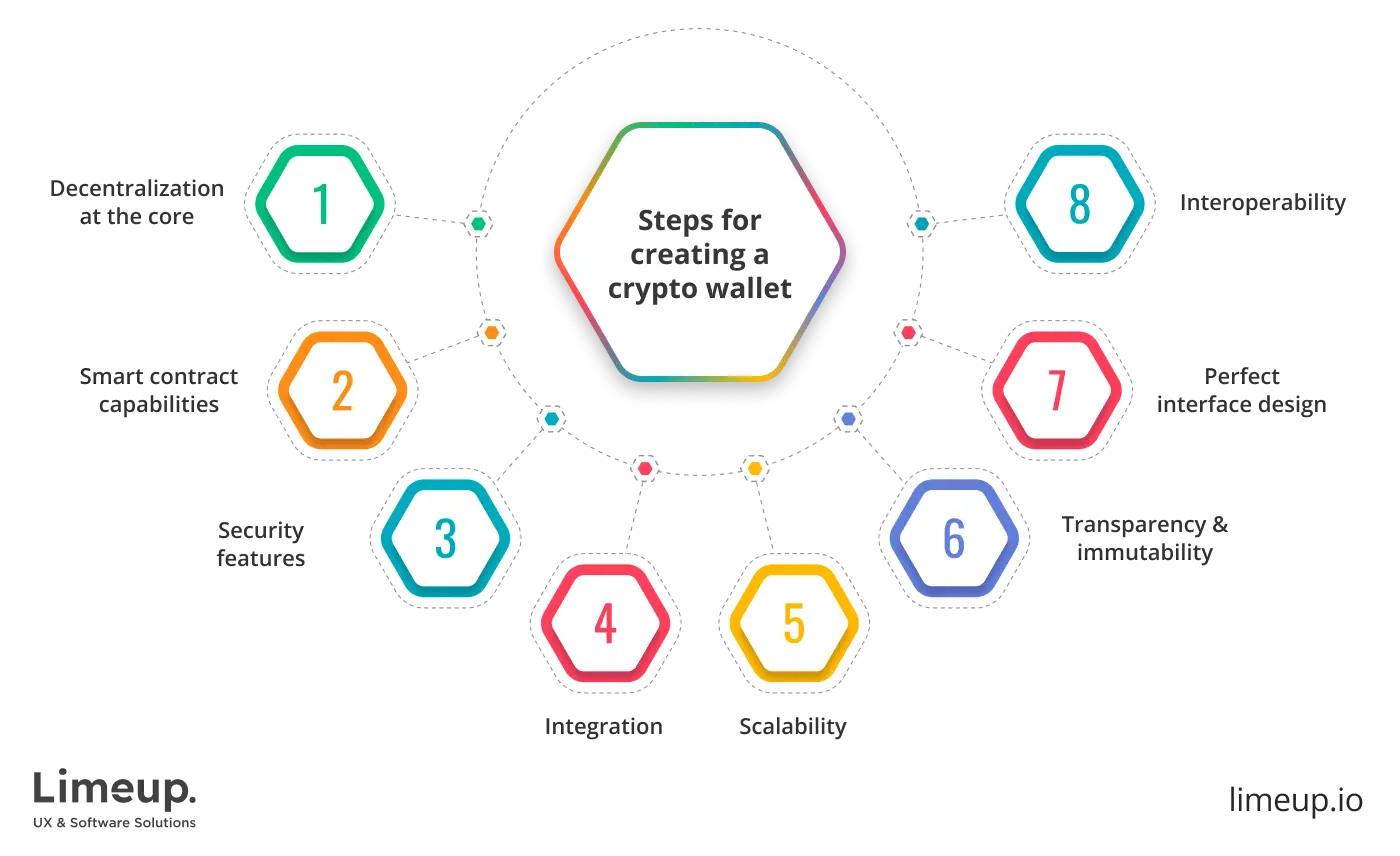
Decentralization at the core. At the heart of blockchain is peer-to-peer structure, which sets it apart from traditional systems. Code-governed digital spaces must uphold independent node governance, ensuring that no central authority controls the data. By allowing users to interact directly with each other without intermediaries, self-executing logic hubs provide greater trust, traceability and security.
Smart contract capabilities. Blockchain’s reliability owes much to logic locked in code, executing workflows with mechanical integrity. Code-based agreements function like silent operators in the blockchain world, firing into action when terms are met, removing the need for banks or brokers. In decentralized finance platforms, they handle everything from lending to yield farming, executing deals with robotic accuracy. Trust is no longer asked for — it’s coded in.
Security features. No blockchain application development is complete without airtight security. Although diffused power minimizes the risk of single points of failure, the addition of multi-signature checks and identity verification tools keeps the bad actors at bay. Guardrails like these make sure data stays in the right hands.
Perfect interface design. No matter how capable the underlying technology is, a clear and intuitive interface makes all the difference. We’ve seen firsthand how a polished layout is able to turn hesitation into confidence. Overloaded screens and puzzling menus? That’s where users drop off. If people need a compass to locate a simple button, something’s gone sideways in the design process.
Transparency and immutability. These two are at the heart of trust in blockchain systems. Every action is permanently recorded, with nothing swept under the rug. Built-in honesty is strategic for us, and be sure that we have worked with companies where immutable records have simplified audits, resolved disputes and strengthened client relationships.
Scalability. Solid groundwork must be laid so that digital ecosystems grow without cracking under pressure. Top-tier vendors implement methods like sharding and layer-2 enhancements to ensure systems expand smoothly. One of our recent blockchain platforms supported a tenfold surge in NFT trading activity by artists and collectors, maintaining seamless performance and cost-efficiency thanks to our custom architecture and user-tested design.
Integration. Blockchain in mobile app development opens ways to advanced functionality by merging with established infrastructures like banking networks or IoT sensor systems. Such fusion enhances operational flow and unlocks new avenues for user interaction, making the application more adaptive and future-ready.
Interoperability. In a world where blockchains multiply like mushrooms after rain, apps need to talk to each other. Cross-chain compatibility lets users interact with different protocols and asset pools without limits. It’s the digital version of speaking multiple languages, essential for survival and growth.
How long does blockchain mobile app development take?
Building a blockchain-powered mobile software is no overnight task. As battle-tested veterans, we may state that timeline hinges on several intertwined factors: the scope of the project, technical requirements, chosen blockchain protocol, integration demands and engineering group strength.
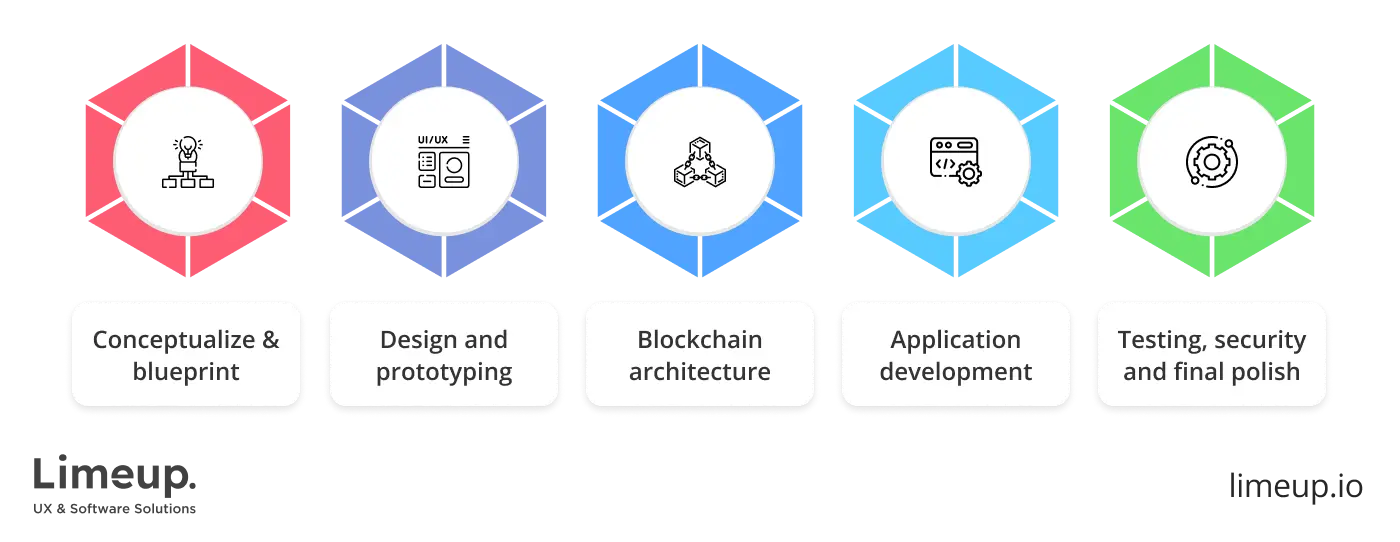
Developing blockchain applications that are reliable, user-friendly rooted in distributed ledger technology calls for a strategic process with no shortcuts or quick fixes. Below is a general breakdown:
| Stage | Estimated duration |
| Initial research and strategy | 2 – 4 weeks |
| Design and prototyping | 3 – 6 weeks |
| Architecture setup | 4 – 8 weeks |
| Smart contract coding | 3 – 6 weeks |
| Front-end and back-end design | 8 – 16 weeks |
| QA and security audits | 4 – 8 weeks |
| Deployment and launch | 1 – 2 weeks |
| Post-launch maintenance | Ongoing |
- Conceptualization and blueprinting
At the outset, every project begins with a well-defined vision. It’s the stage where a blockchain app development company collaborates with stakeholders to clarify the app’s purpose, outline measurable goals, and choose the right blockchain framework. Getting everyone on the same page early keeps the process smooth and spares the team from unnecessary setbacks later.
- Design and prototyping
Concepts start to take shape as ideas transform into clickable designs. This phase brings structure to creativity, mapping each user interaction with precision. What was once a thought now becomes something tangible and engaging.
- Blockchain architecture
You can’t raise a fortress on shaky soil. The crew kicks off by laying down the blockchain core, configuring nodes and agreeing on how the network will validate data. Smart contracts are built with precision and pushed through rounds of testing. If the product touches DeFi or NFT territory, extra caution is a must.
- Application development
Front- and back-end constructions made by blockchain app developers form the meat of the project. The mobile app’s interface is brought to life, API connections are made, wallets are integrated and interactions are tied into the blockchain. Solid coding ensures responsiveness, reliability, and data integrity.
- Testing, security and final polish
Every line of code needs a second (and third) look. QA engineers simulate countless scenarios to ensure stability, while auditors comb through smart contracts for bugs or vulnerabilities. Given the irreversible nature of blockchain transactions, there’s no room for sloppy mistakes.
Ultimately, timelines hinge on the scope of the blockchain app. A basic wallet may take weeks, while larger systems require months of structured development. What stays constant is the value of methodical work, hurried launches often unravel, while deliberate efforts ensure sustained performance.
What is the cost of blockchain app development services?
Creating a cryptographic system involves more than simply coding since it demands delivering resilient secure systems that industry regulations are able to validate. There’s no sticker price for blockchain programming.
What you’ll pay boils down to how sophisticated the system needs to be and the type of technologies it leans on. You might get away with sedan-level spending for a basic dApp, but enterprise-grade systems climb into luxury territory.
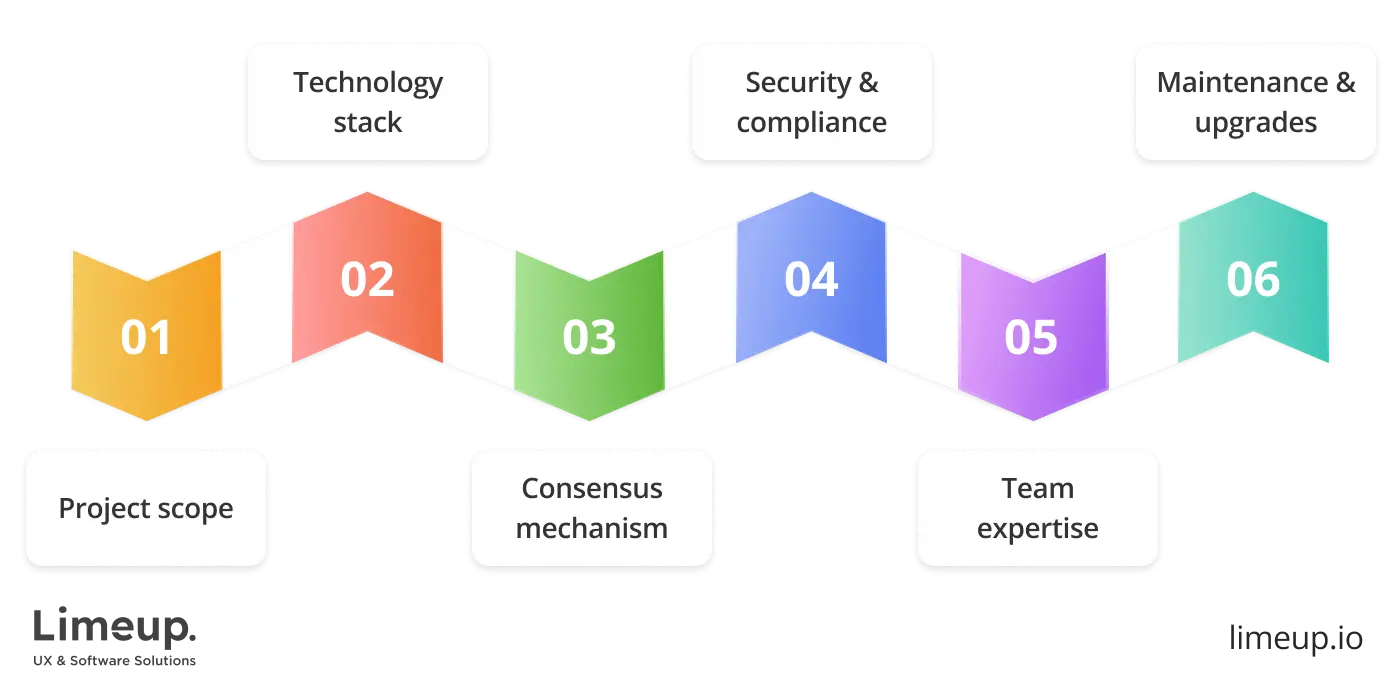
Each step in the blockchain apps development process leaves its mark on the overall investment. Moving from concept to deployment involves distinct stages that require experienced professionals and operational funding:
- Project scope & complexity. A simple smart contract costs less than a full-fledged ecosystem with multiple integrations. The more bells and whistles you add, like multi-chain compatibility or advanced automation, the higher the price tag climbs.
- Technology stack. Public blockchains (Ethereum, Binance Smart Chain) are generally cheaper to develop than private ones (Hyperledger, Corda). Opting for a private network means investing in exclusive infrastructure, custom governance, high-end protective measures.
- Consensus mechanism. Familiar from previous chapters, Proof of Work (PoW) is more expensive due to energy consumption, while Proof of Stake (PoS) is a cost-effective alternative. The decision to develop a blockchain app hinges on the chosen consensus framework that dictates the price tag while defining transaction integrity.
- Security & compliance. Extra precautionary steps, regulatory compliance and encryption are able to drive up the price. Adhering to GDPR, HIPAA, financial industry standards requires rigorous auditing, smart contract testing and top-tier encryption.
- Team expertise. Hiring top-tier peer-to-peer systems creators comes at a premium, but cutting corners here may lead to vulnerabilities. Strong team lays the groundwork for efficiency, fortification, upgrade potential, ensuring your app isn’t a ticking time bomb.
- Maintenance & upgrades. A transaction app isn’t a “set it and forget it” deal as it requires ongoing support and enhancements. Just like sharpening a sword, consistent upgrades, reinforced shielding and protocol refinements keep your app unshakable.
Rates of blockchain app developers
Having top-level tech gurus costs more but choosing less qualified workers puts your application at security risk. Producing trustless transactional products demands regular updates and maintenance services since it does not function as a self-running app.
Early investment in the right minds pays off in fewer bugs, tighter security and smoother launches. Cut corners and you might spend twice fixing them.
| Region | Junior (per hour) | Mid-level (per hour) | Senior (per hour) |
| North America | $50 – $80 | $80 – $150 | $150 – $250+ |
| Western Europe | $40 – $70 | $70 – $120 | $120 – $200 |
| Eastern Europe | $25 – $45 | $45 – $80 | $80 – $130 |
| Asia (India, etc.) | $15 – $30 | $30 – $60 | $60 – $100 |
| Latin America | $20 – $40 | $40 – $70 | $70 – $110 |
| Australia | $45 – $75 | $75 – $130 | $130 – $200 |
Investing in blockchain Android app development the right way may open doors to long-term success, offering you a safe, elastic, next-gen app. Make sure to choose your team wisely — experience is the foundation for excellence. The value of a high-performance interface lies in its ability to spark innovation, reinforce trust and secure your spot at the forefront of your field.
How to select a provider to create your blockchain solution?
The real search begins behind the pitch decks and polished websites. Look past buzzwords and slick presentations. What matters is field-tested skills — teams that have delivered blockchain systems under real-world pressure and know how to build for performance, not just prototypes.

Еvaluate how blockchain app development companies approach decentralized architecture, consensus methods and security protocols. Programmers who truly understand the terrain won’t shy away from deep technical questions as they’ll lead with them. If their pitch sounds vague or relies on trendy lingo, it’s a red flag.
Flexibility is another deal-breaker. Providers stuck in rigid methods often struggle when your project takes a turn, as most projects inevitably do. Choose blockchain IoT app development staff who stay sharp, question assumptions and welcome feedback. The ability to shift gears without falling apart separates well-versed pros from one-hit wonders.
Protection isn’t something to “add later.” It should be woven through every line of code. Ask about their tactics to encryption, smart contract auditing and legal conformity. If they can’t walk you through it in plain terms, keep looking.
Communication rhythms matter more than you’d think. Misalignment between clients and developers often causes project drag or scope detours. Daily syncs, milestone check-ins, and honest feedback loops are the signs of a crew that’s got your back.
Lasting help is just as important as the initial build. Updates, scaling, and bug fixes are part of the deal when you’re building in a rapidly shifting ecosystem. Engineers who vanish after deployment may leave you stranded.
A reliable blockchain app development company works with you, not around you. They’re proactive, adaptive, ready to challenge assumptions, all while staying grounded in the technical grit. Don’t settle for anyone coasting on past glory. Pick builders who are ready to get in the trenches with you.
What are the current trends in blockchain applications development?
Businesses are turning blockchain into their competitive edge because it goes beyond buzzword status by transforming average digital products into revolutionary products. The programs of such technology within mobile tech assets creation space require explanation. We will examine the essential trends which follow.
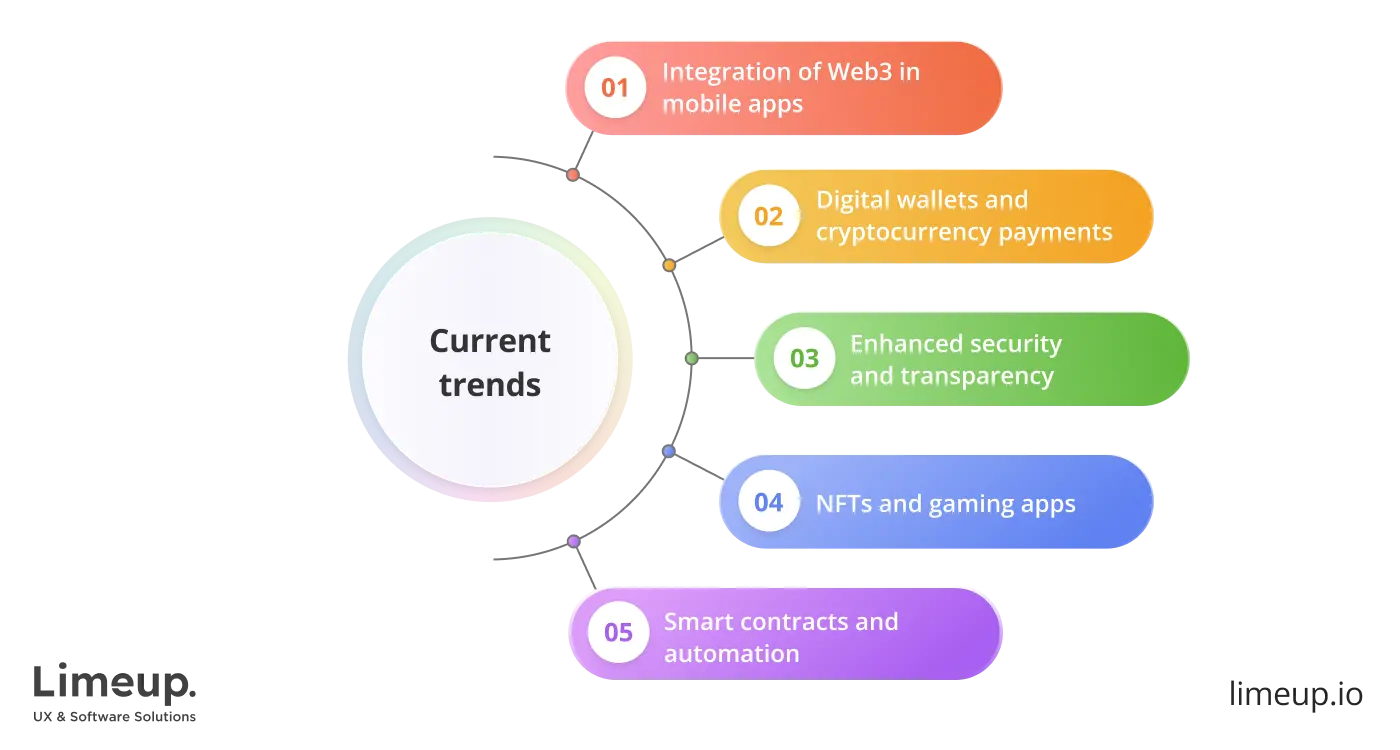
— Integration of Web3 in mobile apps
Instead of relying on a command center, Web3 mobile tools run through distributed systems that put users in charge. This new path of building blockchain applications raises the bar on digital security and gives individuals a clear line to interact with the software, unfiltered by third-party layers.
More mobile programs now add Web3 features to their platform — as an illustration, Coinbase recently launched Apple Pay as a payment option. This milestone enabled the use of Web 3 amidst around 60 million Apple Pay users. Blockchain’s Web3 transformation is underway, particularly with the rise of decentralized finance (DeFi) interfaces and reliable marketplaces.
— Digital wallets and cryptocurrency payments
Today’s mobile wallets have become more advanced than storage solutions for payment methods by providing robust security during cryptocurrency transactions. Although mobile apps continue to add digital payment methods more consumers have the capacity now to easily trade and buy and sell currency with no need to move from their screens. Grasping how to develop blockchain applications is the cornerstone of creating a hassle-free experience.
Consumers are now able to easily trade virtual currencies through engines like Binance because these products allow mobile access to cryptocurrency features. Apps still without this aspect are missing a trick while competitors prepare to scoop up the momentum.
— Enhanced security and transparency
Forget the old playbook. Dispersed setups are rewriting the rules of cybersecurity. Data gets scattered across the system, making it nearly impossible for intruders to crack the whole puzzle. With blockchain app development services engineered for permanence and resilience, your system stands tall, ready to take on whatever knocks at the door.
— NFTs and gaming apps
The rise of non-fungible tokens has sparked a surge in interest from app developers looking to unlock new user experiences. Fueled by non-hierarchical frameworks, clients are now able to tap into NFT trading through mobile services, from marketplaces to games and even social hubs. To create a blockchain app that thrives in this environment, system engineers are embracing the momentum, building frictionless paths for ownership and interaction.
The trend shows no signs of slowing down. Digital collectibles are becoming cultural staples, and game studios are flipping the script by giving players control over in-game assets. Forecasts predict the market will skyrocket to $264.6 billion by 2032, growing at a pace of 28.7% annually. In-game NFTs have transformed playtime into an income stream, opening virtual economies with real-world implications.
— Smart contracts and automation
Self-executing agreements are reshaping mobile application workflows. Packed with the full scope of terms, smart contracts kick in without needing intermediaries. With blockchain entering programming, this type of automation has taken off, offering businesses more control and cutting down on external fees.
Smart contracts deliver exceptional value for real estate payments through their efficient secure operation on mobile tools. Integrated automated contracts give coder an opportunity to build a blockchain application quicker and more transparent interactions that will possibly establish an efficient future.
Why choose Limeup to build your next blockchain application?
What can we conclude after reading the material provided by our specialists? Companies cannot overlook the undeniable effects of blockchain technology because it powerfully reshapes open-source finance sectors as well as enterprise programs. Heavyweights in the sector will suffer a decline if they do not adapt to this shift yet those who accept the potential will build a substantial market advantage.
Limeup’s command of DLT places us at the forefront of the industry, assisting enterprises across the world in converting their bold concepts into sustainable growth. As part of our deep technical abilities combined with market knowledge, we help clients step up to the plate beyond simply following market trends and build a blockchain application that takes them to the top as field leaders.
The applications produced by Limeup utilize decentralized technology to deliver shielded tools as well as DeFi platforms and enterprise-grade solutions that are primed for future scalability needs. As adoption accelerates, firms have a choice: lead the charge or play catch-up. A new chapter is unfolding for those willing to shape it. Reach out to Limeup and take the first step towards transforming your business.

